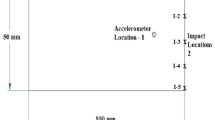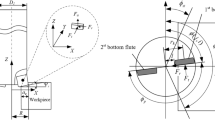Abstract
One of the important factors when dealing with the mechanics of deformable bodies is the variation of the applied force coming on to the body or structure. The present study deals with the indirect measurement of impact forces acting on a shaper tool as direct measurement of these forces is very much difficult. This paper describes one of the indirect force determination methods using frequency response functions. The problem of determining the impact force acting on a body or a structure is the inverse problem. The impact force acting on a tool can be estimated by the responses measured at different points of the cutting tool. The estimation accuracy is improved using singular value decomposition method and Moore–Penrose pseudo-inverse method. Statistical analysis was carried out to determine the level of significance of the experimental method. The experimental method results in accurate identification of impact force which helps in better design and development of cutting tools.












Similar content being viewed by others
References
Li B (2012) A review of tool wear estimation using theoretical analysis and numerical simulation technologies. Int J Refract Met Hard Mater 35:143–151
Al-Ahmari AMA (2007) Predictive machinability models for a selected hard material in turning operation. J Mater Process Technol 190:305–311
Botsaris PN, Tsanakas JA (2008) State-of-the-art in methods applied to tool condition monitoring (TCM) in unmanned machining operations: a review. In: E-Proceedings of the international conference of COMADEM, Prague, pp 73–87
Dimla DE Sr, Lister PM (2000) On-line metal cutting tool condition monitoring: force and vibration analyses. Int J Mach Tools Manuf 40:739–768
Li X, Djordjevich A, Venuvinod PK (2000) Current-sensor-based feed cutting force intelligent estimation and tool wear condition monitoring. IEEE Trans Ind Electron 47(3):697–702
Wang J, Lawb SS, Yang QS (2013) Sensor placement methods for an improved force identification in state space. Mech Syst Signal Process 41:254–267
Ma C-K, Ho C-C (2004) An inverse method for the estimation of input forces acting on non-linear structural systems. J Sound Vib 275:953–971
Martin MT, Doyle JF (2003) Impact force identification from wave propagation responses. J Imp Eng 18(1):65–77
Castro-Triguero R, Murugan S, Gallego R, Friswell MI (2013) Robustness of optimal sensor placement under parametric uncertainty. Mech Syst Signal Process 41:268–287
Thite AN, Thompson DJ (2006) Selection of response measurement locations to improve inverse force determination. Appl Acoust 67:797–818
Liu Y, Shepard WS Jr (2006) An improved method for the reconstruction of a distributed force acting on a vibrating structure. J Sound Vib 291:369–387
Khoo SY, Ismail Z, Kong KK, Ong ZC, Noroozi S, Chong WT, Rahman AGA (2013) Impact force identification with pseudo-inverse method on a lightweight structure for under-determined, even-determined and over-determined cases. Int J Imp Eng 63:52–62
Wan M, Yin W, Zhang W-H, Liu H (2016) Improved inverse filter for the correction of distorted measured cutting. Int J Mech Sci 120:276–285
Gombi SL, Ramakrishna DS (2011) Inverse identification of impact force on a cantilever beam using inverse technique. In: Proceedings of the international conference on smart materials and nano technology in engineering at Shenzhen, China, p 28
Kim S-J, Lee S-K (2008) Experimental identification for inverse problem of a mechanical system with a non-minimum phase based on singular value decomposition. J Mech Sci Technol 22(8):1504–1509
Wang B-T, Lin K-Y (2004) Prediction of harmonic force acting on cantilever beam. In: Proceedings of the 22nd international modal conference, Dearborn, Michigan, Paper No. 64, Session 3
Yang Z, Fang K-T, Kotz Samuel (2007) On the Student’s t-distribution and the t-statistic. J Multivar Anal 98:1293–1304
Karkkainen T, Neittaanmaki P, Niemisto A (1996) Numerical methods for non linear inverse problems. J Comput Appl Math 74:231–244
Author information
Authors and Affiliations
Corresponding author
Ethics declarations
Conflict of interest
The authors declare that there is no conflict of interest regarding the publication of this paper.
Additional information
Technical Editor: Márcio Bacci da Silva.
Rights and permissions
About this article
Cite this article
Patil, R.A., Gombi, S.L. Experimental study of cutting force on a cutting tool during machining using inverse problem analysis. J Braz. Soc. Mech. Sci. Eng. 40, 494 (2018). https://doi.org/10.1007/s40430-018-1411-2
Received:
Accepted:
Published:
DOI: https://doi.org/10.1007/s40430-018-1411-2




